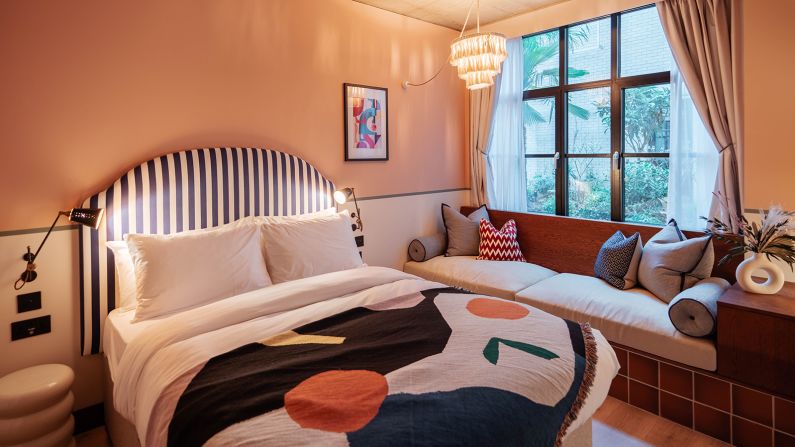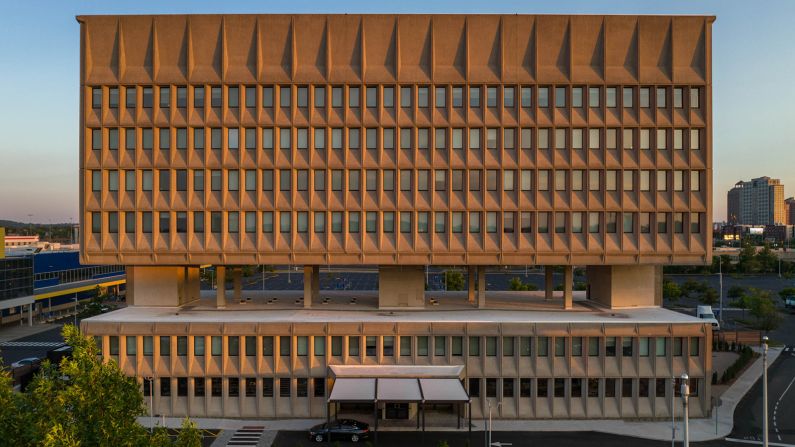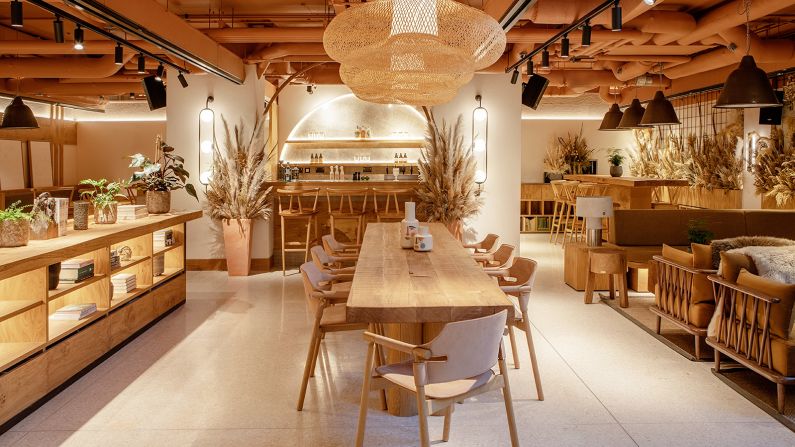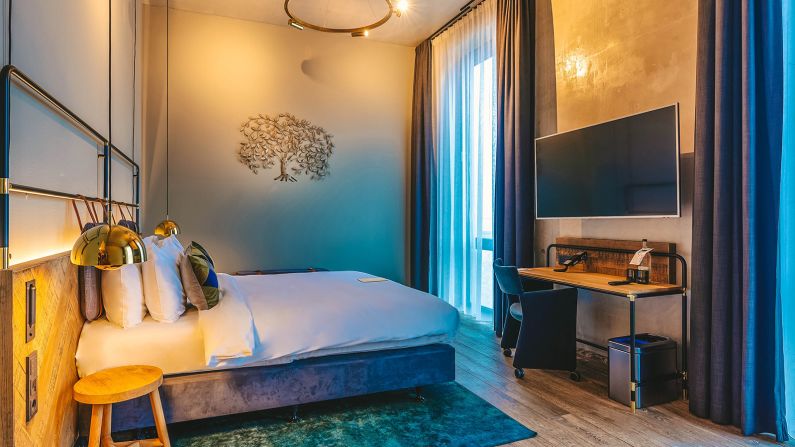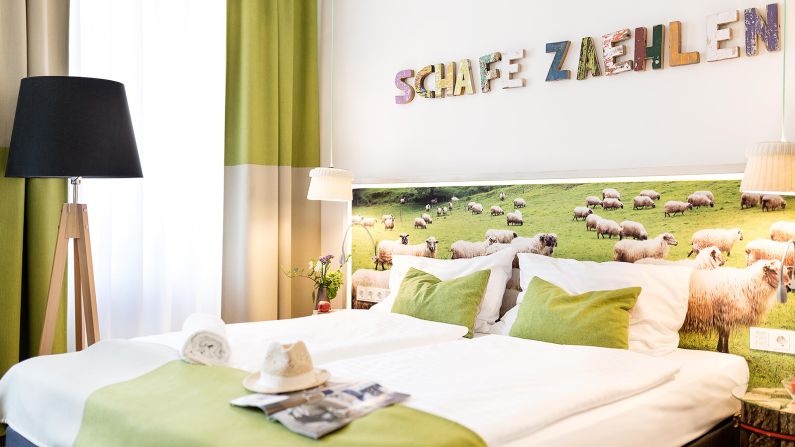Editor’s Note: Monthly Ticket is a CNN Travel series that spotlights some of the most fascinating topics in the travel world. In November, we’re checking into the world of hotels and resorts.
As we wrap up the final months of 2022 and look ahead to a new year, there’s a buzz phrase that’s gaining steam in the world of sustainable travel: net-zero hotels. In other words, accommodations that are powered entirely by renewable energy sources.
As big hotel groups move at a sluggish pace in reducing carbon emissions, a few smaller players are taking the green lead and tackling the climate challenge head-on, boldly committing to a net-zero future well ahead of government targets.
Forget carbon neutral. Soon that term will be passé. Net-zero goes much further than simply paying someone else to offset emissions while still relying on fossil fuels for heating and cooling.
Here’s a look at six hotels and resorts that are leading the way.
room2 Chiswick, London
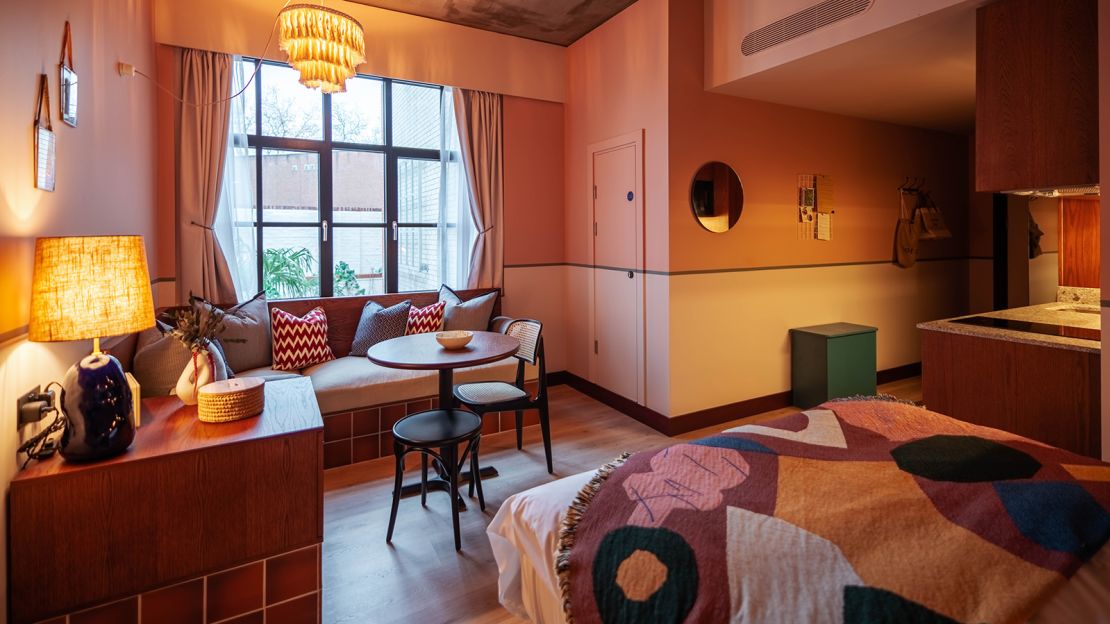
Recognizing the climate crisis, room2 owner Robert Godwin spent two years planning a “whole life” net-zero hotel.
That means shredding the carbon footprint from construction through to running the hotel, which opened in late 2021.
It was built to the most rigorous UK Green Building Council net-zero standards, “to reduce energy demand through design and maximize renewable energy on-site,” he says.
“The result is a hotel that is predicted to be 89% more energy-efficient and shows what can be done.”
Clearly, net-zero energy doesn’t mean net-zero luxury.
At first glance, it might seem like just another design hotel, with its terracotta floors, pendant lights, and lush red velvet bar stools.
Giveaways include the power sensors in rooms and a host of invisible elements like a ground source heat pump, water-saving fixtures, and a ‘blue roof’ that converts rainwater into energy. A biodiverse green roof uses 200 tons of soil and wildflowers aimed to absorb CO2.
room2 Chiswick, 10 Windmill Rd, Chiswick, London, United Kingdom; +44 20 3988 0220
Wren Urban Nest, Dublin
Tucked down a quiet street between Temple Bar and Trinity College, this newcomer declares itself “Dublin’s most sustainable place to stay.”
The capsule hotel with 137 pod rooms or “nests” was designed “using advanced carbon reduction technologies,” says architect Michael Mullen.
“The ventilation system captures 81% of rejected heat using a thermal wheel and heats incoming fresh air for free,” he adds.
That energy is also used for hot water, while the hotel kitchen snubs gas. Water conservation and low-loss fittings make water demand “approximately 60% lower than a typical hotel”.
Running on 100% renewables earns it the World Green Building Council’s “net-zero operational carbon” stamp.
Peep in and you will quickly realize that ditching carbon offsets doesn’t put a dint in design. Scandinavian minimalism – wood, wicker lights and natural hues – meet Irish textiles and furniture, and abundant greenery.
“Cosy” and “Snug” bedrooms, just 9.5-12 square meters (102-129 square feet), pack in “compact luxury” with amazing energy efficiency. But that doesn’t rule out Chromecast and lightning-fast WiFi. Or handmade soaps, locally crafted mugs and rugs, and roasted coffee.
Wren Urban Nest, St Andrew’s Lane, Dublin, Ireland; +353 1 223 4555
Comfort Hotel Solna, Sweden
In June 2021, Scandinavia welcomed its first certified “zero-energy” hotel. The 336-room Comfort Hotel Solna lies a few miles north of central Stockholm.
The angular building sports 2,500 square meters of colorful solar cells, making it “the world’s most photovoltaic-dense.”
“We generate enough solar power to send a Tesla around the world 50 times!” the hotel boasts on its website. And more than its annual energy needs.
“Nothing is left to chance,” says owner Petter Stordalen. “The elevators charge when they go down to power the ascent. The building is cooled and heated by heat pumps that fetch energy from borehole bearings (underground thermal energy storage).
From the maritime-themed rooms to industrial-chic Barception (the bar-reception), this “energy-smart” hotel shows off Nordic design while being relatively easy on the wallet. The light-filled space is fitted with wood, raw steel, earthy colors, and Bakelite bowl suspended lighting.
Comfort Hotel Solna, Evenemangsgatan 48, 169 56 Solna, Sweden; +46 8 121 614 80
Boutiquehotel Stadthalle, Austria
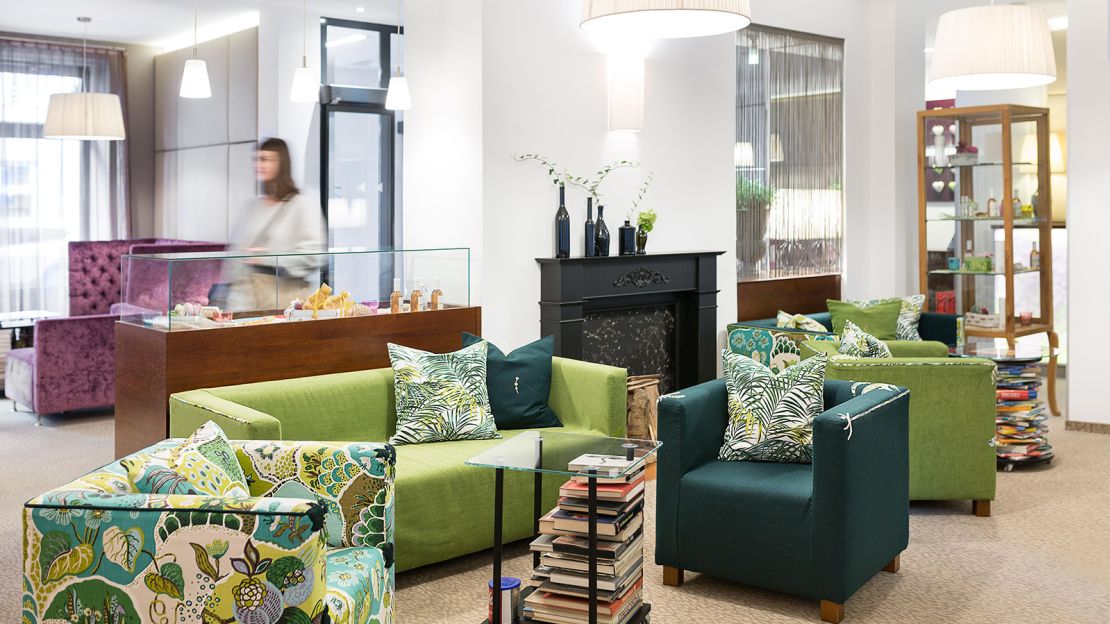
Long before hotels began touting their net-zero virtues, it turns out there was a true zero-emissions pioneer in Vienna.
In a restored turn-of-the-century house surrounded by solar panels and garden beds, the 79-room Boutiquehotel Stadthalle has been running on solar power and other renewables since 2009.
“A zero-energy balance may not sound sexy for a hotel,” says owner Michaela Reitterer. “But our guests think it is. About 70% stay because of our ‘green at heart’ vision.
“We generate as much energy in a year with a groundwater heat pump, solar panels and photovoltaic technology as we consume. Excess goes into the grid and sometimes in peak seasons, we source surplus renewable energy from the city, such as Biomass.”
The quirky rooms flaunt recycled wine bottle chandeliers, upcycled wood furniture, sheep bedheads and Klimt prints. Forget energy-guzzling minibars. Try a few chords on a piano instead.
Breakfast is in the interior courtyard “oasis” among herb pots, flowers, and ivied walls. Up above, the lavender roof bursts with butterflies and bees.
Hailed as Vienna’s “green queen,” Reitterer says she took a really long-term view betting on renewable energies in her quest to “change the world,” starting out in a “sustainability Stone Age.”
Boutiquehotel Stadthalle; Hackengasse 20, 1150 Wien, Vienna, Austria; +43 1 9824272
Hotel Marcel, New Haven, Connecticut
The new Hotel Marcel New Haven, part of the Tapestry Collection by Hilton, is a 165-room hotel inside the city’s iconic Pirelli building that’s “powered solely by the sun” and is fusing a legendary past with a climate-first future.
It operates independent of fossil fuels, resulting in zero carbon emissions.
The hotel is expected to be certified as the first net-zero hotel in the US, while also receiving LEED Platinum and Passive House certifications. (Hotel reps tell CNN the net-zero certification process requires 12 months of third-party verification and monitoring of various systems.)
“Fossil fuels are really a 20th-century technology, and they are more expensive to use now,” says Bruce Becker, the architect-developer behind Hotel Marcel.
“A net-zero hotel is really self-sufficient and makes all the energy it uses.”
The brutalist landmark was transformed using smart building technology, from thermal insulation to an energy recovery system and air-source heat pumps that transfer outside air indoors. Again, this means 80% energy savings, with no skimping on style.
“Over 1,000 solar panels generate all the electricity to meet the needs of the building,” says Becker.
“Solar panels covering the rooftop and parking canopies provide 100% of electricity for lighting, heating, cooling, and electric car charging stations.”
Behind its gridded concrete facade, the Hilton Tapestry Collection hotel boasts walnut furniture, white terracotta tiles and Bauhaus geometric print rugs – all custom-designed.
The rooms have touchpad controls for controlling temperature, lighting, and automatic shades. Triple-glazed windows and dramatic views of Long Island Sound meet curated art, retro lights and original wood-paneled walls.
Hotel Marcel, 500 Sargent Dr, New Haven, CT, United States; +1 203 780 7800
Four Elements Hotel, Amsterdam
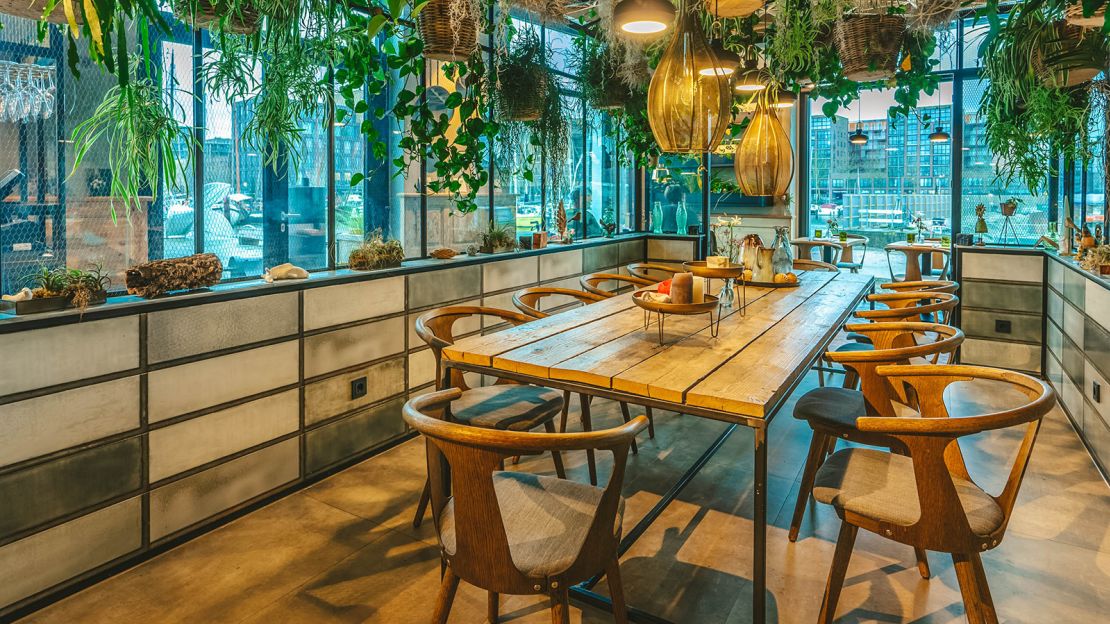
This “eco-luxe” hotel on the edge of Amsterdam’s Ijmeer Lake snuck in almost unnoticed in 2019.
A BREEAM-certified building in the city’s Ijburg neighborhood, Four Elements Hotel uses wind turbines to produce energy for air conditioning and heating. A solar chimney harvests power to heat water, while a solar facade of gleaming photovoltaic panels converts energy into electricity.
The “Earth, Wind & Fire” idea came from engineer Dr. Ben Bronsema, who found African termite mounds stay the same temperature through extreme climate conditions by opening and closing doors to create “natural air conditioning”.
Never has green looked so sexy as from the top floor Wind Sky Bar, with its recycled wood banquettes, exposed pipes, orange poufs and peacock blue fabrics. Meanwhile, the Herbs Garden restaurant fancies traditional fermentation, preserving, pickling and smoking.
The decor in the 195 rooms is also Dutch gezellig cozy. Behind the moss encased numbers lie salvaged timber floors and repurposed brass bedheads and architectural lighting.
Four Elements Hotel, Bert Haanstrakade 1074, 1087 HJ Amsterdam, Netherlands; +31 20 714 2040
